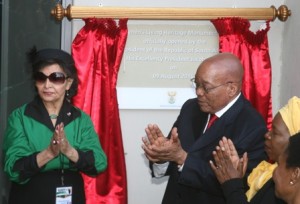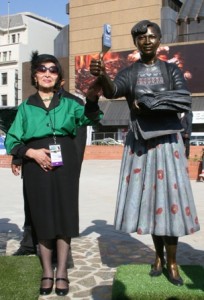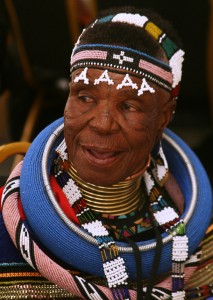
The national holiday, in recognition of the 9 August 1956 march on the then Apartheid-era Union Buildings to protest against the state’s extension of the restrictive ‘dompas’ laws upon African women by some 20 000-strong mixed-race protesters from all walks of life notably led by Helen Joseph, Lilian Ngoyi, Rahima Moosa and Sophie Williams-De Bruyn – had the first of the alluded to events witnessing a mixed throng gather on Lilian Ngoyi Square [changed from Strijdom Square on the 50th anniversary of the march] for the official opening of the Women’s Living Heritage Monument by President Jacob Zuma – in addition to the unveiling of the life-size statues of the four previously mentioned stalwarts of the march.
With most of the Zuma administration’s cabinet in attendance, albeit mainly the female members such as the monument’s conceptualizer in the form of then Gauteng premier David Makhura, Nomvula Mokonyane and Minister in the Presidency responsible for Women, Susan Shabangu, ANC Women’s League president, Minister Bathabile Dlamini, Chairperson of the African Union Commission, Dr Nkosazana Dlamini-Zuma – as well as the remaining member of the prominent quadruple in the form of Williams-De Bruyn along with 22 others who participated in the initial mid-20th century march, the president was joined by his deputy, Cyril Ramaphosa, Minister of Arts and Culture, Nathi Mthethwa, Minister Shabangu and Williams-De Bruyn [who according to the occasion’s programme unfurled Rahima Moosa’s statue] in unveiling the four activists’ likelinesses.
Having proceeded to unveil a plaque as well as cut the ribbon at the entrance to the monument, the president and his entourage were then given a brief tour of the multi-tiered space which also features, inter alia, an interactive installation enabling visitors to call the biographies of South Africa’s prominent female figures – at the touch of a screen!
Soon thereafter, was the turn of the assembled women to take to the beckoning street to re-enact the original, FEDSWA [Federation of South African Women]march immortalized in monochromatic outtakes of the bygone era – enroute to a now democratic seat of government at the Union Buildings, some good walking distance afar off!
Looking rather in fine fettle for a septuagenarian and equally resplendent in the all too familiar black skirt and green blouse of the ANC’s women league, Williams-De Bruyn joined a fair smattering of ministers such as Maite Nkoana-Mashabane and Edna Molewa, in addition to women rights lobby groups such as Commission for Gender Equality, Abanqobi Women Together, Mine Healthy Safety Council [donning pink hard hats] and numerous others – for the tread up Stanza Bopape street, with some of the marchers all the while brandishing placards registering unequivocal lines screaming: Rape is not Love and, Love does not mean Abuse!
Ahead but within their scope was a parade of police, deliberately mainly policewomen on duty on the day peradventure, with a hearty moment provided when the ladies in blue happened to spot erstwhile commissioner, Bheki Cele, cutting some figure in a swish suit and a trademark fedora, in the marchers’ midst – prompting some to urge, “Buya Ndosi!” Still, further on, a female captain intoned, “Almost there ladies!”This constituted the second stanza of the day’s event spurred on by songful abandon.

The third happening of the occasion unfolded just below the outstretched arms of Madiba’s statue on the Union Building’s amphitheater lawns of a warm winter’s day canvassed by a tide of mainly green and gold and black for the formal programme directed by ministers, Shabangu and Mthethwa and included a parade of the SANDF, a 21-gun salute, welcome remarks by the Premier of Gauteng, Minister Dlamini, Chairperson Dlamini-Zuma, Williams-De Bruyn and the presentation of scrolls by the country’s premiers [to signify their contributions toward women empowerment in their respective provinces] to the president – and the head of state’s delivery of the keynote address on the auspicious occasion.
On a sunny midday in the capital, some 62 years after the adoption of the Women’s Charter calling for full political rights for women and men and for equal pay for equal work, whilst proclaiming a single society in which women share the problems and anxieties of men and join hands with them to remove social evils and obstacles to progress, Williams-De Bruyn now held sway at the podium whilst expressing to all gathered how she felt blessed and revived of spirit presently.
Having initially provoked bursts of good-natured mirth when a name, that of Nomvula Mokonyane, she seek to evoke in expression of her own gratitude for the then Gauteng premier’s acknowledgement of hers and fellow activists contribution to the Struggle with the establishment of the monument, momentarily slipped her memory – she, upon reminding, soon regained fort by proceeding on to delve into the maladies of poverty, unemployment and inequality whilst bemoaning the abuse of women and children in a democratic South Africa.
The launch of the monument touched her, she let the audience know whilst musing back to the earlier port of call at the square by alluding to how she noted that the four unveiled statues were depicted smiling – thus rendering her: proudly South African.
That, to a then teenager of 19 who back in ’56 in the aftermath of their epoch-making feat said, “This was the first time ever in the rule of the apartheid government that black people, worst of all women, ever set foot and walked on their ‘holy grail’, the forbidden soil – the Union Buildings.
I still wonder to this day what went through their minds.” Different eras, different posers!
When it came the turn of Minister of Social Development, Bathabile Dlamini to occupy the stage,the ANC Women’s League president held back no punches in slamming the prevailing patriarchal composition of the country’s society – even taking an opportunistic and rather unceremonious swipe at the demographic of the media corps covering the event – some few meters below from the stage she was negotiating her address.
Thanking the president for the 21 gun salute executed pending a rendition of the national anthem by a military band, Dlamini also lambasted racism in workplaces and institutions of learning whilst turning to tell Zuma that the ANC women’s league maintains that, if you teach a woman, you teach a nation. Venting in the same vein, the minister further bemoaned the silence and complicity in the suppression of victims of abuse whilst cautioning against the depiction of women as objects in the media space.
African Union Chairperson, Dr Nkosazana Dlamini-Zuma posed as to who’d had thought that there would be a holiday in honour of women? She made mention of the fact that the oldest varsity in the world, in Africa, was founded by an African woman and issued forth a clarion call that the struggle [for women] continues.
Turning to Zuma and Ramaphosa seated immediately behind her, Dlamini-Zuma stated, “If South Africa is weak, the whole continent is!”
Seemingly in unison, every notable speaker on the programme evoked the rallying cry of, “Wathint’abafazi! Wathint’ imbokodo! Uzo kufa!”[You touch women, you touch a rock – you’ll perish] – which found automatic flavour with the enthusiastic crowd spread across the expansive lawns and onto the huge marquee sheltering VIPs such as Ndebele artist, Esther Mahlangu, Dali Tambo, Abigail Kubheka, Dorothy Masuka and numerous cosmopolitan sojourners come to witness the commemoration of history.
It was within this very space teeming with the who’s-who, that Williams-De Bruyn was literally turned into a celebrity by the intra-generational guests who clamoured around her and jostled for photo-ops and selfies.
President Jacob Zuma’s keynote address had him fluctuating from English to Zulu as he acknowledged the day’s march again by women coming from around the country for affirmation and restoration of birth-rights.
FEDSWA, then, challenged the stereotype of women’s place being in the kitchen, he offered – going on to quoting Oliver Tambo’s acknowledgement of women’s participation in South Africa. Zuma also caught attendees with a recalling of how the womenfolk of that time sent an unequivocal message to the apartheid regime’s then incumbent head of state [J G Strijdom] that: if you touched women, the rocks – you’d die!

If Dr Dlamini-Zuma, earlier in her remarks had laid the gauntlet at the current government’s door to support women’s economic empowerment, glimmers of the manifestation of that exhortation in action were made visible for visitors to behold in the form of an adjacent marquee to the VIPs one, as the formers’ floor plan contained a display of paraphernalia and various wares ranging from the edible to the not so really edible – by women who clearly had and continued answering the clarion call.
Textiles extended to the ubiquitous, yet trendy statement-making head scarves donned by most of the ANC women in attendance as they mingled with contemporaries of hues reflecting the nation’s diversity – in notable addition of spotting Chinese visitors proudly dressed in doeks, in unconscious assimilation of their hosts’ norms.
The day’s afternoon cultural segment had programme director, Thembi Seete, delighting the throng through introducing renditions by fellow musicians ranging from, Deborah Fraser, old hands, Dorothy Masuka and Abigail Kubheka, Nothembi Mkhwebane, The Muses, Babes Wodumo, etc. – as the lineup ensured that the guests rounded off the momentous day with a rocking flourish!
Interspersed somewhere between the speeches was a notification to the audience that at the time of the original march, the then regime had tried to deal the participants a malicious hand by suspending the bus service on the day in the hope that it would dissuade them from reaching their seat of power – only for the ill-advised measure to implode on their watch as the determined souls, some, mothers with babies on their backs walked, rode donkey carts, trains and exercised which other means to ensure that they did got to registered their objections to Strijdom’s ruler ship.
At Pretoria railway station, 60 years on to the day, history repeated itself as delegates from the eastern and western Cape, who had come to the capital by train – prepared for the journey back home as they were seen unpacking their luggage from successions of pickups arranged by the organizers to assist in the transfers from their hotels to the departure point.
The sense of being part of history past and present was no doubt, not lost on them as they transited from one Sir Herbert Baker masterpiece to another – bearing vocabulary souvenirs for families, acquaintances, peers, neighbours, colleagues, etc. back home!
